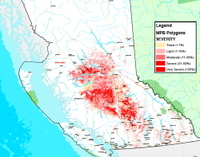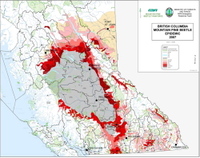AND now it’s snowing, and I’ve got the shoes to prove it. That’s the mud from yesterday’s marathon session on the outside of the clogs, and the snow from today on the inside. If you’re wondering why my shoes are outside rather than inside, then you didn’t read my last post. For shame.
What’s up with your weather?
It appears that I’m not the only one seeing snow in May. Amy of High and Dry commented on my last post that snow’s only just giving way to rain for her. Of course, if you check the maps on Blotanical, you’ll find that she’s stuck herself way north in British Columbia, so what does she expect? (It looks to me as if she’s the furthest north of all on that garden forum.) (Being born there is no excuse.)
And truth to tell, snow in May, in Montana? It happens. (And I moved here on purpose, so I definitely have no excuse.)
But jodi DeLong (that’s how she writes her name folks, so take it up with her, not me) of bloomingwriter in Nova Scotia, one of the most temperate spots in Canada, started a post yesterday by asking plaintively, " Is anyone else having a May like this?" This, below a photo of flowers (primroses?) in the snow. (They look lovely.)
Even odder, a week ago or so I saw a comment by a blogger in Texas (I don’t remember who) exclaiming over their late, cold spring. Not to mention the horrific tornadoes in Missouri and Oklahoma. Aren’t they supposed to come in August?
It’s enough to make you wonder.
A guy I know here in Montana, fed up with April (and May) snow showers, claims he’s going to start a group called Montanans for global warming. He’s trying to get my goat, or course. I think I’ll join, to get his.
Of course, global warming might not "help" us anyway. That’s the weirdest thing about it, to my mind: it doesn’t just warm everything up. It plays havoc with the weather.
Melting ice in the Arctic might not only threaten polar bears, but also disrupt the Gulf Stream, the massive Atlantic current that sweeps north along North America, turns east, and flows south, warming Europe. If it’s disrupted, scientists predict colder weather in Europe.
Here in Montana, and up and down the Rockies, warmer winters mean that the pine beetle,  which is killed off by the cold, is laying waste to forests. When the trees die and decay, the carbon dioxide they’ve sequestered is released back into the atmosphere. The problem is most serious in Canada’s western province of British Columbia; so bad, it might worsen global warming.
which is killed off by the cold, is laying waste to forests. When the trees die and decay, the carbon dioxide they’ve sequestered is released back into the atmosphere. The problem is most serious in Canada’s western province of British Columbia; so bad, it might worsen global warming.  Talk about a tightening spiral: global warming leads to the death of trees, which worsens global warming. The top figure here (produced by Natural Resources Canada) shows the extent of the infestation in 2006; the bottom one (produced by Canada’s Ministry of Forest and Range) shows the situation one year later, in 2007. The unreadably tiny legend says that the gray area is "overrun."
Talk about a tightening spiral: global warming leads to the death of trees, which worsens global warming. The top figure here (produced by Natural Resources Canada) shows the extent of the infestation in 2006; the bottom one (produced by Canada’s Ministry of Forest and Range) shows the situation one year later, in 2007. The unreadably tiny legend says that the gray area is "overrun."
Even closer to home–as close as my back yard–the pine beetle infestation means that bears can’t feed on the cones as they once could, so they’re more inclined to go into campgrounds and (yes) city streets. It’s very romantic to have had a mother bear and two cubs spend the night in our trees as they did a couple of autumns back, but it doesn’t bode well for bears, forests, or humans. (I was a little worried about one of my neighbors, too; more than slightly inebriated, he wanted to shake the tree and call the bears down.)
Does anyone else see changes that might–for no one knows for sure–be caused by global warming?





 Subscribe to RSS feed
Subscribe to RSS feed


